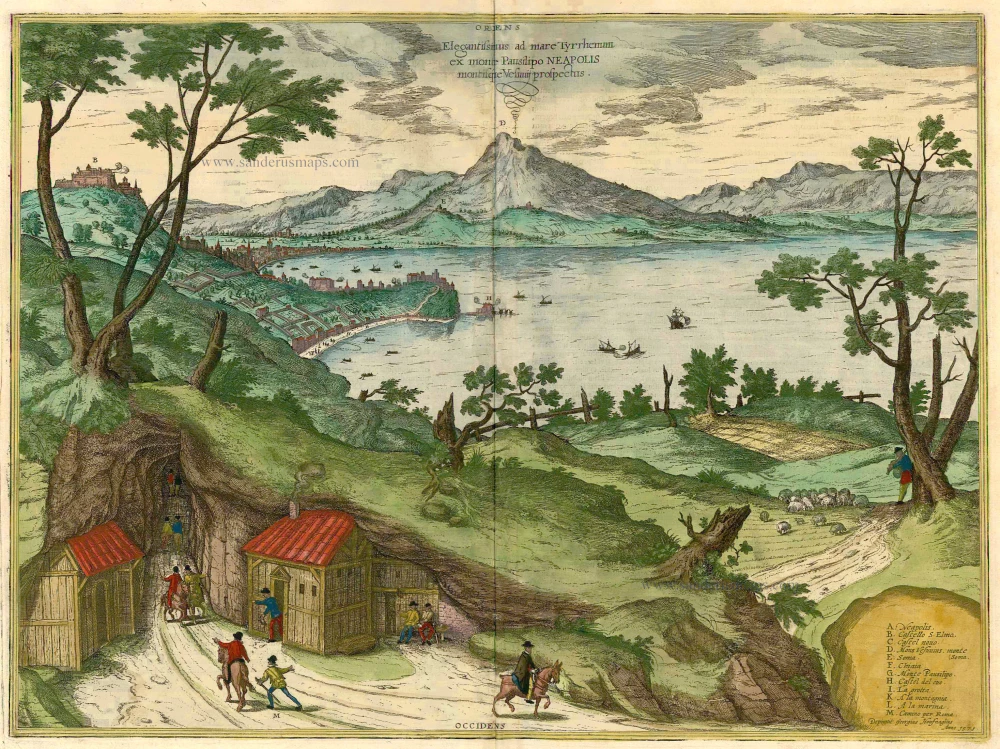Antique map of Naples - Vesuvius by Braun & Hogenberg 1596-1640
Elegantissimus ad Mare Tyrrhenum ex Monte Pausilipo Neapolis Montisque Vesuvius Prospectus
Item Number: 12928 Authenticity Guarantee
Category: Antique maps > Europe > Italy
Bird's-eye view of the Bay of Naples with mount Vesuvius, by G. Hoefnagel, 1578.
TRANSLATION OF CAPTION: The most beautiful view from Mount Posilippo of Naples on the Tyrrhenian Sea and of Mount Vesuvius.
Signed an dated bottom right: Painted by Georg Hoefnagel in the year 1579.
COMMENTARY BY BRAUN: "Mount Vesuvius is particularly noteworthy because so many authors describe it and it lies near Naples beside the sea. Strabo describes it as follows: Mount Vesuvius has a fertile soil, except at the very top of the mountain, where there is a barren plateau, where hollow pits with scorched stones can be seen that grow ever deeper on account of the great heat. It is therefore assumed that fuel and tinder that burns well are present within, and that the burning will only cease when this material runs short or is used up. In the middle it has a chasm that is thought to be bottomless and to extend deep into the earth; from this it expels its fire."
As a complement to the bird's-eye of Naples in Volume I, this plate offers an atmospheric view of the Gulf of Naples looking towards Vesuvius in the centre, located just 9 km from the city. Overlooking the city from Vomero Hill is the Castel Sant'Elmo, characterized by symbolic cannon fire. An impressive ancient tunnel can be seen in the foreground, the Grotta di Posilippo (I), which had been widened only a few years earlier, under Viceroy Don Pedro de Toledo, and which provided convenient access to Pozzuoli and Baia from Naples. The entrance in fact lies at a 90-degree angle to the opening shown here, where it has been altered for the sake of the composition. Naples lies between two active volcanic regions, Vesuvius and the Phlegraean Fields. Amongst Vesuvius's many terrifying eruptions, probably the most famous was the one that destroyed Pompeii on AD 24 August 79. The volcano has been dormant since 1944. Naples arose around 750 BC out of two Greek colonies; the Greeks named the rapidly growing town "Nea Polis", signifying "New Town". During the Roman Empire Naples and its neighbours Capri, Herculaneum and Pompeii became popular summer residences of the Roman upper classes. After being ruled by a number of different dynasties over the centuries, in 1442 Naples was conquered by King Alfonso V of Aragon, who made it the capital of his southern Italian kingdom. (Taschen)
Copper engraving
Size: 36.5 x 48.5cm (14.2 x 18.9 inches)
Verso text: Latin
Condition: Old coloured.
References: Taschen, Braun and Hogenberg, p.424.
From: Civitates Orbis Terrarum, ... Part 5. Köln, 1598.

